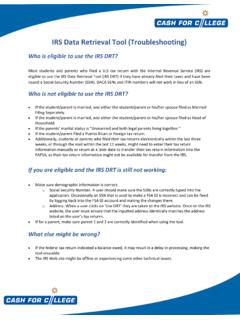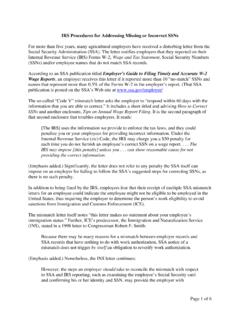Transcription of IRS History Timeline - IRS tax forms
1 March 2019 IRS History TimelineInternal revenue Service2 The Bloody Massacre Perpetrated in King Street, Boston on March 5, 1770." | Paul Revere | 1770 | Prints and Photographs Division, Library of CongressTaxation without representation was the seed of the American Revolution. Colonists rebelled against Britain s punitive taxes because they had no voice in parliament. On July 4, 1776, the Declaration of Independence severed ties with England. The Revolutionary War ended in 1783, and a new nation was and RevolutionInternal revenue Service3 Alexander Hamilton| John Trumbull | 1806 | National Portrait Gallery, Smithsonian Institution | Gift of Henry Cabot LodgeOn February 21, 1787, Congress approved a Constitutional Convention to revise the Articles of Confederation.
2 The Congress shall have the power to lay and collect taxes, duties, imposts, and excesses, to pay the debts and provide for the common defense and general welfare of the United States. On September 2, 1789, Congress established the Department of the Treasury and appointed Alexander Hamiltonas the first of TaxationInternal revenue Service4 Washington Reviewing the Western Army at Fort Cumberland, Maryland | Frederick Kemmelmeyer | circa 1795 | Metropolitan Museum of Art | Gift of Edgar William and Bernice Chrysler Garbisch, 19631794 saw the first outright challenge to the government s revenue laws when a federal court summoned 75 distillers in western Pennsylvania to appear in court and explain why they shouldn t be arrested for whiskey tax evasion. The Whiskey Rebellion set up a clash between citizens and federal officers.
3 The federal government prevailed, but at a cost of $ million to American Whiskey RebellionInternal revenue Service5 Capture and Burning of Washington by the British, in 1814 | Illustration in Our First Century by Richard Miller Devens | 1876 | Library of CongressTo pay for the War of 1812, Congress passed new internal taxes on refined sugar, carriages, distillers and auction sales and reinstated the Commissioner of the revenue to collect them. On August 24, 1814, the British burned the Treasury building in Washington, December 23, 1817, Congress repealed these and all remaining internal taxes and abolished the position of the Commissioner of the revenue and all offices to collect War of 1812 internal revenue Service6 Architectural drawing of the Treasury building | Mills, Robert, 1781-1855, architect | 1842 | Library of Congress Prints and Photographs Division Washington, began on a new Treasury building in 1836.
4 The first segment opened in Treasury Gets a New HomeInternal revenue Service7 Abraham Lincoln papers: Series 1. General Correspondence. 1833-1916: Salmon P. Chase to Abraham Lincoln, Thursday, July 03, 1862 (Recommendation)| Lincoln, Abraham, 1809-1865 | July 3, 1862 | Abraham Lincoln Papers at the Library of CongressOn July 1, 1862, President Lincoln signed the second revenue measure of the Civil War into law. This law levied internal taxes and established a permanent internal tax established the Office of the Commissioner of internal revenue under the Department of the Treasury. On July 17, 1862, George S. Boutwell became its first War ExpensesInternal revenue Service8 Treasury department, July 25, 1864. To the people of the United States. By an act of Congress, approved June 30, 1864, the Secretary of the Treasury is authorized to issue an amount not exceeding two hundred millions of dollars in Treasury notes | U.
5 S. Treasury dept. | Washington, 1864 | Broadsides, leaflets, and pamphlets from America and EuropeIn its first year, 1863, the Office of the Commissioner of internal revenue collected $ revenue Act of June 30, 1864, authorized the Commissioner of internal revenue to compromise all suits relating to internal revenue , to abate outstanding assessments and to refund taxes subject to current Seizures and Tax RefundsInternal revenue Service9 Hydrometer| Designed by Giuseppe Tagliabue of New York, NY. | circa 1867 | SIA Acc. 11-006, Box 005 -United States National Museum. Division of Graphic Arts, Photographic Collection, 1860-1960 | Smithsonian Institution ArchivesIn February 1867, the Secretary of the Treasury adopted a hydrometer to establish a uniform system to inspect and gauge alcoholic spirits subject to March 1, 1867 revenue Act authorized the Secretary of the Treasury to adopt, procure and prescribe these and other weighing and gauging instruments to prevent and detect fraud by spirit TechnologyInternal revenue Service10 Will he dare do it?
6 | Nast, Thomas, 1840-1902, artist | March 2, 1878 | Nast, Thomas, 1840-1902. Illustrations and political cartoons by Thomas Nast | Library of Congress Prints and Photographs Division Washington, (later president) James Garfield of Ohio spearheaded an effort to make tax information private. On April 5, 1870, IRS Commissioner Delano forbade tax assessors from furnishing lists of taxpayers for publication. On July 14, 1870, Congress passed a revenue act stating, no collector .. shall permit to be published in any manner such income returns or any part thereof, except such general statistics .. 1870 Personal PrivacyInternal revenue Service1116th Amendment to the Constitution: Federal Income Tax | Congress | 1913 | National Archives at Washington, February 25, 1913, the 16th Amendment officially became part of the Constitution, granting Congress constitutional authority to levy taxes on corporate and individual Bureauof internal revenue established a PersonalIncome Tax Division and Correspondence Unittoanswer a flood of questions aboutits enforcement, and aspecial division withinGeneral Counselto prepare opinions interpreting internal revenue Federal Income TaxInternal revenue Service12 Original form 1040 | 1913 | From , a joint undertaking of the National Archives & Records Administration, National History Day, and the USA Freedom CorpsOn January 5, 1914, the Treasury Department unveiled the four-page form (including instructions)
7 For the new income tax. The form was numbered 1040 in the ordinary stream of numbering forms in sequential order. In the first year, no money was to be returned with the forms . Instead, each taxpayer's calculations were verified by field agents, who sent out bills on June 1. Tax payments were due by June 1040 internal revenue Service134 Minute Men -A message from Washington | Welsh, H. Devitt, 1888-1942 | 1917 | Library of Congress Prints and Photographs Division Washington, 1917, the internal revenue Bureau launched a special nationwide public education program to help citizens understand the new tax burden. The campaign tried to popularize war taxes by emphasizing the needs of the country and appealing to national pride and patriotism. Four Minute Men fanned out across the nation, preaching the importance of paying taxes promptly and AwarenessInternal revenue Service14 New York City Deputy Police Commissioner John A.
8 Leach, right, watching agents pour liquor into sewer following a raid during the height of prohibition | 1921 | Library of Congress Prints and Photographs Division Washington, passed the National Prohibition Enforcement Act on October 27, 1919. It prohibited the manufacture, sale, and use of intoxicating beverages. It also designated the Bureau of internal revenue as the enforcement agency. The Bureau hired and trained hundreds of prohibition agents to enforce the law and created a new intelligence unit to uncover corrupt prohibition agents and revenue Service15 internal revenue Service Headquarters Building, 1111 Constitution Avenue Northwest, Washington, | Historic American Buildings Survey | after 1933 | Library of Congress Prints and Photographs Division Washington, June 1, 1930, the main section of the new internal revenue building opened, 16 months ahead of schedule and with a total construction cost of just over $6 addition to a state-of-the-art fire alarm system, it contained 1,400 telephones and a synchronized system of 861 clocks.
9 The largest system of its kind at the of internal revenue Gets New HomeInternal revenue Service16Al Capone | Unidentified Artist | December 26, 1925| National Portrait Gallery, Smithsonian InstitutionAmerican gangster Alphonse Al Capone attained fame during the Prohibition era by raking in millions of dollars through bootlegging and other illicit activities. In 1931, an IRS Intelligence Unit investigation led to his indictment on federal income tax evasion and violations of the Volstead Act. He pled guilty, was convicted, and sentenced to 11 years in federal prison, a $50,000 fine, and ordered to pay $215,000 plus interest on back CaponeInternal revenue Service17 Franklin D. Roosevelt | Oskar Stoessel | 1940 | National Portrait Gallery, Smithsonian Institution; gift of David E.
10 FinleyOn August 14, 1935, Franklin D. Roosevelt signed the Social Security Act. Employees originally paid one percent of the first $3,000 of their salaries to finance the benefits. The law required a new system of tax withholding, which the Bureau of internal revenue had to collect and turn over to the Social Security Trust Fund. It also created an unemployment compensation program and laid the foundation for modern payrollwithholding. 1935 Payroll WithholdingInternal revenue Service18 Stamp 'em out: Buy stamps and bonds | Byrne, Thomas A., artist, Federal Art Project, sponsor | Library of Congress Prints and Photographs Division Washington, Roosevelt administration hoped to pay for at least half the cost of World War II by increased taxation. The 1942 revenue Act sharply increased most existing taxes, introduced the Victory tax (a 5 percent surcharge on all net income over $624 with a postwar credit), lowered exemptions and began provisions for medical and dental expenses and investors expense , taxes only funded 43 percent of the war s cost, 7 percent short of the TaxInternal revenue Service19 The Punched Card | Trade publication for the Punched Card Publishing Company | 1952 | National Museum of American History , Gift of Thomas J.












